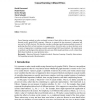Free Online Productivity Tools
i2Speak
i2Symbol
i2OCR
iTex2Img
iWeb2Print
iWeb2Shot
i2Type
iPdf2Split
iPdf2Merge
i2Bopomofo
i2Arabic
i2Style
i2Image
i2PDF
iLatex2Rtf
Sci2ools
JMLR
2010
2010
Causal learning without DAGs
Causal learning methods are often evaluated in terms of their ability to discover a true underlying directed acyclic graph (DAG) structure. However, in general the true structure is unknown and may not be a DAG structure. We therefore consider evaluating causal learning methods in terms of predicting the effects of interventions on unseen test data. Given this task, we show that there exist a variety of approaches to modeling causality, generalizing DAG-based methods. Our experiments on synthetic and biological data indicate that some non-DAG models perform as well or better than DAG-based methods at causal prediction tasks.
| Added | 19 May 2011 |
| Updated | 19 May 2011 |
| Type | Journal |
| Year | 2010 |
| Where | JMLR |
| Authors | David Duvenaud, Daniel Eaton, Kevin P. Murphy, Mark W. Schmidt |
Comments (0)

